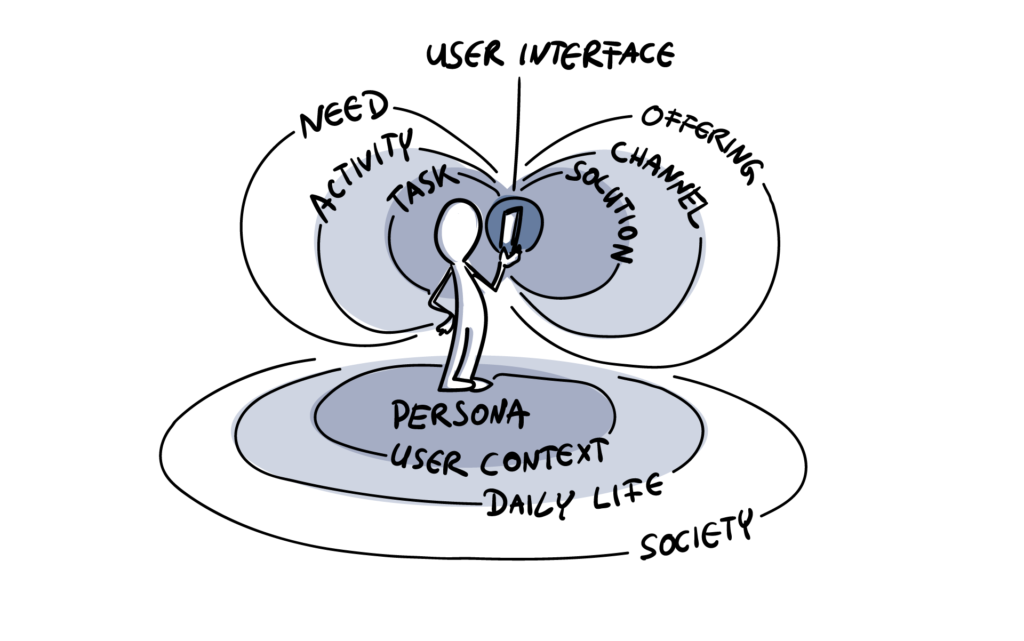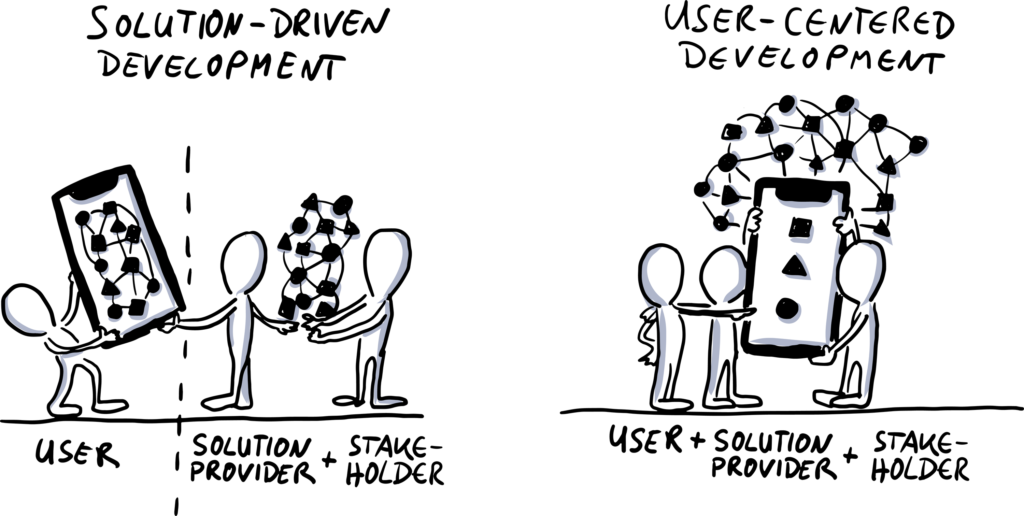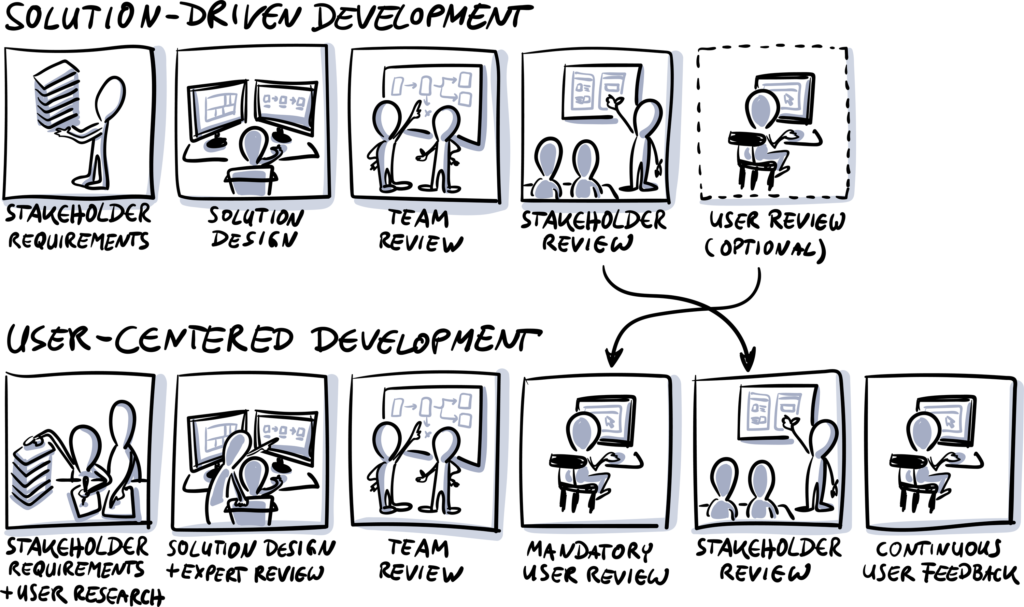
Why should we be interested in User Experience?
In the digital world, user needs and what you offer as a solution meet on a relatively small screen. It is hard to design the user experience as a result of this meeting in detail. However, we would like to present a lean user-centred approach for solution providers that increases the likelihood of a great user experience.
The User Experience (UX), i.e. how intuitively we cope and how well we are supported in completing our tasks, determines the success of digital solutions[1]. Depending on the user involvement in a service or product, this influence on success is to a greater or lesser extent.
There are also good reasons to pay attention to UX as neobanks and new fintechs focus on frequent banking use cases with competitive added values AND surprise through simple UX. Meanwhile, Swiss bank clients are open to trying out new banking solutions. If the new banking solution proves itself in everyday practice, a slow change will take place. A ‘Best of Personal Fit’ approach, where different banking solutions are combined based on individual preferences, can already be seen.[2]
It is therefore important to look at the holistic context of use and to build up a close relationship with the users to provide them with the appropriate offers, which should also be easy to use.
HOW can we make ourselves think, not the user?
UX as a discipline means not only focusing on the experience our users have when using our solutions, but also establishing a mindset and framework for it in our company. This can be achieved by building up the appropriate skills and knowledge, using suitable methods and integrating them into the development process.

It is therefore a matter of establishing a conscious and structured UX process in which the U – the user – plays a central role in UX. We must find out what the users need or – with far more difficulty – even find out what they do not even know they need yet. We should think ahead so that the user does not have to when operating our solutions.[3]
The best way to do this is to continuously involve users in the development process. When we see this not as a chore, but as an opportunity to learn about our users, we begin to take the first step towards a great UX, where our users love using our solutions.
WHAT can we do to put the U in UX?
At Finnova, as a solution provider for the financial sector, our employees play a key role in establishing a new lean user-centred approach. We do not mean lean as skipping in-depth research or scientific procedures, but rather as an immediate booster to get started.
We have committed ourselves to the following simple principles:
- Small steps: Hands-on action rather than building up theoretical frameworks upfront
- Sustainable knowledge: Fostering knowledge transfer and practical experience within the company
- Everyday language: Avoiding UX buzzwords while establishing the user-centred mindset and methods
Based on these principles, we have developed measures to help our employees and teams to switch from the inside-out to a user-centred perspective and sharpen their senses for real user inputs.
1. Measures for individual development
Product owners and requirements engineers should also know how to conduct user-centred methods. We strive for collective responsibility, not bundling competences in single UX roles:
- Offer individual UX learning paths with focus according to the role, e.g. value proposition workshops[4] () for product owners or UX research methods, prototyping, usability testing for requirements engineers
- Offer different sources of user insights through first-hand research (interviews, surveys, feedback tools), UX best practice and benchmarking databases[5] or even holistic profiling and behavioural analytics data to fully understand your customer[6]
- Encourage participation in hands-on UX processes for employees through usability tests, design sprints, UX hackathons, etc.
- Focus on UX mindset and knowledge for the recruitment of new employees
2. Measures for teamwork and collaboration
Our overall goal is to have UX knowledge and competence within each team – to strengthen teamwork and collaboration:
- Clear definition of UX tasks and deliverables throughout the development process
- Establishing of ‘UX champions’, former regular team members that specialise in a certain UX field to help their team
- Setup of Communities of Practice to share experiences between the teams and building up UX knowledge for specific topics (research, requirements engineering, prototyping, front-end development, etc.)
3. Involving key roles
In our case, a clear commitment to investing in user-centred activities by management was key, not only in speeches or PowerPoint slides, but also by providing an explicit UX budget as well as an additional UX workforce.
Through the new user-centred approach, we try to create awareness for needs and not just solutions in our community of customers and partners. This is certainly one of the hardest parts, as each customer or partner has its own approaches when it comes to user engagement. Here we try to use synergies and share knowledge, while also encouraging them to participate in user research or co-creation workshops with their users.
Users need to have a voice in the development process. The formerly passive role of users has shifted to an active one: giving real-time feedback, comparing with other solutions, and claiming new features. We embrace this as a chance to work together. In our experience, users who are involved in the development are also the most loyal customers and promoters of that solution.

This approach is not a master plan to rule it all. It is more a mix of measures that you can adapt to your company’s needs and conditions. We are at the beginning ourselves, but we are happy to follow this user-centred path with our customers, partners and users of our solutions. This is why we do not consider UX as a separate stream but as an integrated part of product development.
Conclusion: Trusting the process
One of the most important things about UX is that you do not get lost in definitions and theory. Trust the UX process and the UX superpower to involve your users – you will learn and adapt. Love the U in UX and the U will love you back.
As seen in other superhero scenarios, with great power comes great responsibility. So, if you know what your users want and how they think and act, you may fall into the trap to use this to manipulate them into a desired behaviour that may be good for your business in the short term, but not good for the users themselves. These are known as dark patterns, like hidden costs, trick questions or confirmshaming[7]. Avoid these by all means. Stay away from the dark side.

by Alwin Seiverth
User Experience Specialist Digital Banking
Finnova AG
[1] Source: EY Bankenbarometer 2022
[2] Source: SwissBanking/Accenture, Perspectives on the future of Swiss banking
[3] Source: Don’t make me think, Revisited by Steve Krug
[4] Source: Value Proposition Design by Strategyzer
[5] Source: Scientia Fintech Insights
[6] Source: Finnova Analytical Framework
[7] Source: 10 Evil Types of Dark UX Patterns
